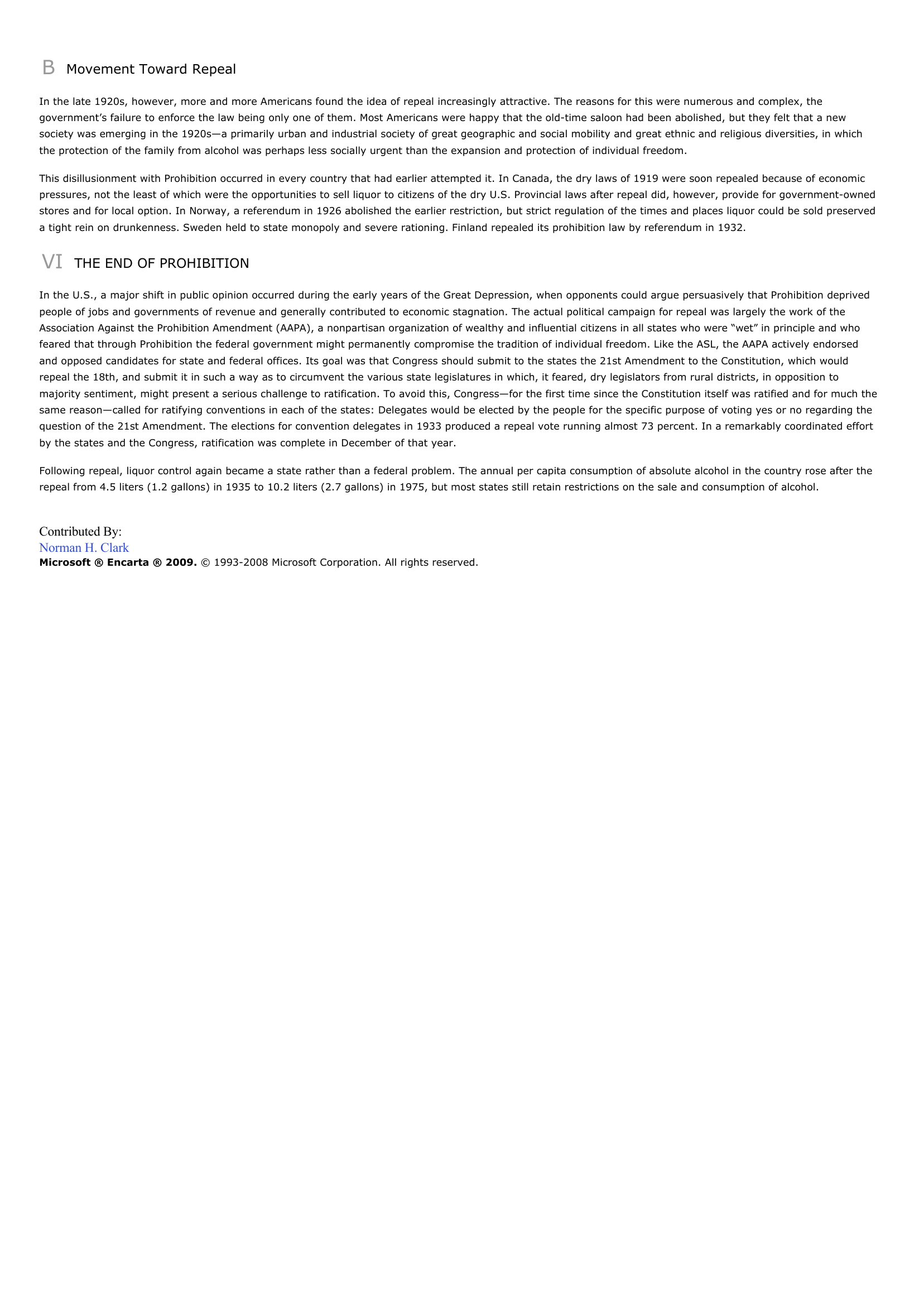Prohibition - U.
Publié le 02/05/2013

Extrait du document
«
B Movement Toward Repeal
In the late 1920s, however, more and more Americans found the idea of repeal increasingly attractive.
The reasons for this were numerous and complex, thegovernment’s failure to enforce the law being only one of them.
Most Americans were happy that the old-time saloon had been abolished, but they felt that a newsociety was emerging in the 1920s—a primarily urban and industrial society of great geographic and social mobility and great ethnic and religious diversities, in whichthe protection of the family from alcohol was perhaps less socially urgent than the expansion and protection of individual freedom.
This disillusionment with Prohibition occurred in every country that had earlier attempted it.
In Canada, the dry laws of 1919 were soon repealed because of economicpressures, not the least of which were the opportunities to sell liquor to citizens of the dry U.S.
Provincial laws after repeal did, however, provide for government-ownedstores and for local option.
In Norway, a referendum in 1926 abolished the earlier restriction, but strict regulation of the times and places liquor could be sold preserveda tight rein on drunkenness.
Sweden held to state monopoly and severe rationing.
Finland repealed its prohibition law by referendum in 1932.
VI THE END OF PROHIBITION
In the U.S., a major shift in public opinion occurred during the early years of the Great Depression, when opponents could argue persuasively that Prohibition deprivedpeople of jobs and governments of revenue and generally contributed to economic stagnation.
The actual political campaign for repeal was largely the work of theAssociation Against the Prohibition Amendment (AAPA), a nonpartisan organization of wealthy and influential citizens in all states who were “wet” in principle and whofeared that through Prohibition the federal government might permanently compromise the tradition of individual freedom.
Like the ASL, the AAPA actively endorsedand opposed candidates for state and federal offices.
Its goal was that Congress should submit to the states the 21st Amendment to the Constitution, which wouldrepeal the 18th, and submit it in such a way as to circumvent the various state legislatures in which, it feared, dry legislators from rural districts, in opposition tomajority sentiment, might present a serious challenge to ratification.
To avoid this, Congress—for the first time since the Constitution itself was ratified and for much thesame reason—called for ratifying conventions in each of the states: Delegates would be elected by the people for the specific purpose of voting yes or no regarding thequestion of the 21st Amendment.
The elections for convention delegates in 1933 produced a repeal vote running almost 73 percent.
In a remarkably coordinated effortby the states and the Congress, ratification was complete in December of that year.
Following repeal, liquor control again became a state rather than a federal problem.
The annual per capita consumption of absolute alcohol in the country rose after therepeal from 4.5 liters (1.2 gallons) in 1935 to 10.2 liters (2.7 gallons) in 1975, but most states still retain restrictions on the sale and consumption of alcohol.
Contributed By:Norman H.
ClarkMicrosoft ® Encarta ® 2009. © 1993-2008 Microsoft Corporation.
All rights reserved..
»
↓↓↓ APERÇU DU DOCUMENT ↓↓↓
Liens utiles
- La prohibition de l'inceste chez Sigmund FREUD
- prohibition, n.
- De la prohibition à la criminalité (anthologie de textes juridiques).
- La prohibition de l'inceste chez Sigmund FREUD
- Quel est le rôle de la prohibition de l'inceste ?




